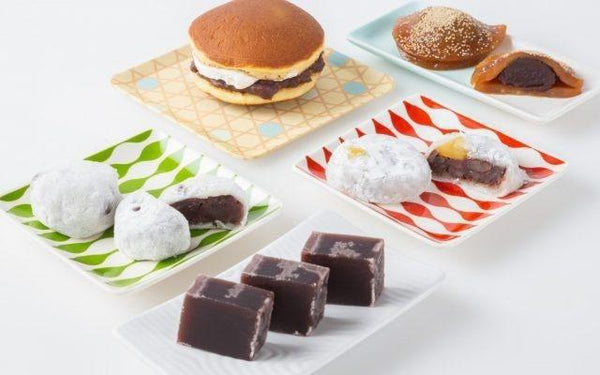
Jump to:
What are Wagashi?

Wagashi are traditional Japanese sweets that are typically served alongside a cup of hot green tea. Translated directly as “Japanese Sweets” or “Japanese Snacks”, the term wagashi was coined during the Meiji period. As the world was opening up in the mid 19th century, the word wagashi was created in order to differentiate Japanese sweets from European sweets. Later in the Edo period, wagashi became commonly included in Japanese tea ceremonies, as it compliments the bitterness of Japanese green tea very well.
Wagashi is not just one type of Japanese dessert, it is actually an umbrella term used for Japanese sweets. Wagashi differ in the ways that they are prepared, as well as their shapes, textures, and ingredients. It is said that many wagashi are made with plant based ingredients, but this is not held to a strict standard these days. Wagashi are also thought to be healthier than western desserts, as they do not contain any processed ingredients.
Common ingredients included in wagashi are sweet bean paste made from azuki red beans and mochi, but these are not strict requirements for what is classified as wagashi in Japan. Since its creation, many different types of sweets have been added to the wagashi category. When it comes to variations of wagashi, some are popular and can be found in Japan year round, while some are popular based on the location or season of the year. Furthermore, popular seasonal motifs that can be found in wagashi would be sakura for spring or leaves for autumn.
Want to learn more about wagashi? In this article, we are going to go over a curated list of the top 10 Japanese wagashi you should know about. While all of them are traditional, some of them have Japanese roots while some of them have western roots. You may be surprised to learn what is classified as wagashi! Stay tuned to learn more about the world of wagashi.
Dango

Dango are sweet Japanese rice dumplings made of glutinous rice flour. You may think that dango are similar to mochi, but they are actually made differently. Mochi is made from steamed and pounded rice, while dango is made from glutinous rice flour. They are also smaller in size compared to mochi. Dango was created to be a sweetened version of mochi, which does not traditionally contain any sugar. They are also a wagashi enjoyed year round in Japan, but seasonal variations also exist.
Texture wise, dango are very chewy and firm due to the use of glutinous rice flour. Dango can come plain, or in other flavors such as matcha. It is common to see dango smothered in various ingredients such as red bean paste or a sweet-soy sauce glaze. Dango are often served on a skewer, typically with 3 to 5 dumplings per skewer. They also taste the most delicious when they are freshly made.
Daifuku

With a name that literally translates to “big luck”, daifuku are made of soft and round rice cakes and are wrapped around a smooth ball of red bean paste, shiroan (sweetened white bean paste), or other fillings such as fruit. The ratio of filling used is often equal to or greater than the amount of mochi used. Sometimes the mochi is colored to give the daifuku a cute appearance, but it does not always have to be. Daifuku is also served covered with a light dusting of potato or corn starch to keep them from sticking together. They can be quite messy to eat!
Traditionally, red bean paste is used as a filling, but these days fruit variations such as strawberries or muscat grapes, and even ice cream are popular filling choices. Daifuku are best eaten fresh, and are often enjoyed as a dessert. Similarly to dango, daifuku exists to be a sweetened version of mochi, but is always filled with something rather than coated.
Sakura Mochi

Sakura Mochi are a seasonal wagashi featuring the flavor of Japanese cherry blossoms. A pink-colored rice cake with a red bean paste center is wrapped in a pickled cherry blossom leaf, making sakura mochi. They also have a soft sakura scent.
There are two versions of sakura mochi that can be found in Japan. They are known as the Kanto and Kansai styles. The Kanto style uses glutinous rice flour, giving the mochi a small, rolled pancake appearance. On the other hand, the Kansai style uses actual sticky glutinous rice that has been lightly pounded, giving the mochi more texture.
Sakura mochi are traditionally eaten during the springtime, especially on occasions such as hinamatsuri or hanami picnics. While sakura mochi pairs well with any green tea, it pairs especially well with genmaicha or hojicha.
Manju

Manju are small buns that are either steamed or baked and contain a filling. The most common variation of manju is a steamed bun filled with red bean paste. The dough can be left plain, but matcha powder is sometimes added to give the manju a green exterior.
Manju can come in different shapes or sizes, and even have different fillings depending on the region. For example, momiji manju, a common confection in Hiroshima, is a maple leaf-shaped manju containing red bean paste, custard, or other fillings.
The outer layer of manji is often smooth and made from wheat, so it may not be a suitable dessert for those with gluten allergies.
Ohagi

Named after the seasonal flower はぎ or Japanese bush clover, Ohagi is a traditional sweet usually eaten around the fall or spring. It is referred to as Ohagi in the fall and Botamochi in the spring, but we will refer to it as Ohagi in this post. Ohagi uses steamed glutinous rice that is pounded until half of the grains are mushed while the other half remain whole, giving it quite a unique texture compared to other wagashi. It is then covered in red bean paste, black sesame paste, or roasted soybean flour.
Dorayaki

Dorayaki may be one of the more commonly known wagashi! It is essentially a sandwich consisting of two pancake-like patties filled with red bean paste. The pancakes contain honey, so they have a light honey flavor, as well as a deep golden brown color.
In Japanese, “dora” means gong, and because the pancakes are round and share a similar shape to a gong, this is probably where it got its name from. “Yaki” is also the word used to describe something that is baked or grilled. Thus, compromising dorayaki.
Taiyaki

Taiyaki is a fish-shaped snack made with a batter similar to a waffle batter and traditionally filled with red bean paste. The “tai” in the name refers to seabream, the shape of this wagashi, and yaki' refers to the way this snack is baked in a fish-shaped mold. Taiyaki are best eaten when they are freshly made and still warm.
While red bean paste is the most common and conventional filling for taiyaki, custard cream, cream cheese, sweet potato, and other unique flavors can be found as fillings in taiyaki shops. These fish-shaped treats are not too sweet either, so they can be enjoyed either as a snack or dessert.
Castella

This is the most westernized wagashi on this list. Castella is a popular Japanese honey sponge cake made of flour, eggs, sugar, and syrup starch. Unlike western cakes, castella does not contain butter or oil. Castella is not originally a Japanese confection, in fact its roots come from Portugal. However, this cake has now become a speciality of Nagasaki city, located in the Kyushu region, or southernmost island of Japan.
Castella is known for having a dark golden brown crust while having a soft and fluffy center. Castella also typically comes in three different flavors which are plain, chocolate, and matcha. While castella is a cake, it is not overly sweet or heavy as it has been refined to fit the palettes of Japanese people.
Anmitsu

Anmitsu is a dessert that consists of sweet bean paste, mochi dumplings, fruits, boiled peas and cubed kanten agar. Fresh fruits such as strawberries, kiwi, mandarin oranges, and bananas are commonly featured as toppings for anmitsu. It is dressed with a black or brown sugar syrup, known as “mitsu” in Japanese. Sometimes a scoop of ice cream is even added. Since it is served chilled, it is a popular summer dessert.
Konpeito

These tiny and star-shaped sugar candies are also classified as a Japanese wagashi. They were first introduced in the 16th century by Portuguese traders, but later became classified as a Japanese wagashi. Konpeito are hard sugar candies that have a grainy texture. They are made only from sugar, water, and edible food flavoring/coloring.
Konpeito are often gifted in elaborate gift boxes or are featured in Japanese festivals such as hinamatsuri and tanabata.
Want to discover even more types of wagashi? Check out our full comprehensive list of wagashi types.


0 comments